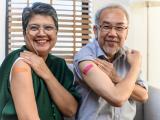Two new analyses from Sweden and Pakistan published in BMJ highlight the benefits of partial or full COVID-19 vaccination in preventing persistent symptoms.
Vaccination tied to 58% lower risk of long COVID
In Sweden, University of Gothenburg researchers led an observational evaluation of the efficacy of primary COVID-19 vaccination (two doses followed by a booster) against long COVID, or post-COVID condition (PCC), among adults whose first infections were recorded in a national registry from December 2020 to February 2022. Average follow-up was 129 days.
Among 299,692 vaccinated participants, 7.0% received only one dose, 68.6% received two, and 24.3% had at least three. Participants were considered vaccinated if they had received at least one dose before infection.
The findings highlight the importance of primary vaccination against covid-19 to reduce the population burden of PCC.
Of all participants vaccinated before infection, 0.4% were diagnosed as having long COVID during follow-up, compared with 1.4% of their 290,030 unvaccinated peers, a nearly four-fold difference. Receipt of at least one vaccine dose was tied to a lower risk of long COVID (adjusted hazard ratio, 0.42), for a vaccine effectiveness (VE) of 58%. VE against long COVID for one, two, and three or more doses was 21%, 59%, and 73%, respectively.
"The results of this study suggest a strong association between covid-19 vaccination before infection and reduced risk of receiving a diagnosis of PCC," the researchers wrote. "The findings highlight the importance of primary vaccination against covid-19 to reduce the population burden of PCC."
Calls for more research and vaccination prioritization
They called for continued research on the evolution of long COVID and other viral diseases, as well as actions to "improve the accuracy of recording both recovery and continued illness after infection, and in quantifying key family, social, financial, and economic outcomes."
"Such estimates are fundamental to unlocking the funding required for future research and increased investment in specialist clinical services offering treatment and rehabilitation to support patients with post-viral conditions," they added.
In a related commentary from United Kingdom experts, Manoj Sivan, MD, of the University of Leeds, Mike Ormerod of National Health Service Fife and Public Health, and Rishma Maini, MBChB, MPH, of the University of St. Andrews, said that pandemic preparedness plans should continue to prioritize the rapid manufacture, evaluation, and distribution of vaccines.
"Given a plausible link between viral illnesses and long term syndromes such as chronic fatigue syndrome/myalgic encephalitis and fibromyalgia, it would be prudent to advocate timely vaccination to reduce the healthcare burden and adverse impact on the economy," they wrote.
Vaccinated group more likely to return to work
For the prospective Pakistani study, Aga Khan University researchers analyzed rates of persistent symptoms among 481 COVID-infected adults admitted to the university hospital from February to June 2021, with telephonic follow-up at 1 year. The average age was 56.9 years, 61.7% were men, and the most common chronic conditions were diabetes (55%) and high blood pressure (26%).
Of the 474 patients with known vaccination status, 19.0% and 19.2% were fully and partially vaccinated, respectively. A total of 64% of patients were severely or critically ill, and 25.6% required noninvasive mechanical ventilation. The death rate after hospital release was 4.6%, and 18.9% were readmitted to the hospital, 31.8% of them because of respiratory involvement and 17.6% because of infection.
This study reports that the patients continued to have debilitating symptoms related to long COVID, one year after discharge, and most of its effects were observed in patients with severe/critical disease and unvaccinated patients.
Rates of severe illness were higher in unvaccinated patients than in their vaccinated counterparts (68.2% vs 58.5%), with critical disease in 27.3% and 20.4%, respectively. Overall, 29.9% of patients had symptoms of long COVID, which were more common in those with severe or critical illness (35.5%) and the unvaccinated (37.9%). The most prevalent symptoms were fatigue (26.2%), shortness of breath (24.1%), and cough (15.2%).
New or worse long-COVID symptoms were reported by 37.9% of the unvaccinated cohort, compared with 20% of the vaccinated population. Severe fatigue (33.9% vs 17.1%), shortness of breath (30% vs 17.1%), cough (20.9% vs 8%), difficulty walking due to breathlessness (15.8% vs 8%), and fever (8.3% vs 2.2%) were also more common in the unvaccinated group than in their vaccinated peers.
Vaccinated patients, compared to their unvaccinated peers, had lower hospital readmissions (13.8% vs 21.51%) and post-COVID lung complications (15.4% vs 24.2%). After adjustment for age, sex, chronic illnesses, and disease severity, unvaccinated status was an independent predictor of long COVID (odds ratio, 2.42). Fully and partially vaccinated patients had a respective 62% and 56% lower risk of long COVID.
Of the 266 patients who answered questions about employment status, 45% of the vaccinated group was able to return to work, compared with 12.8% of the unvaccinated.
"This study reports that the patients continued to have debilitating symptoms related to long COVID, one year after discharge, and most of its effects were observed in patients with severe/critical disease and unvaccinated patients," the researchers wrote.


















